Report
“I drove a motorcycle more than 100 km in order to buy a microdrip irrigation system.” —Smallholder farmer in Karnataka, India
Much has been written about smallholder farmer behavior and what drives farmer adoption of innovations. However, much of this writing is narrowly focused (on one crop or one technology in a certain region) or lacks specific business implications to inform management decisions.
In this chapter, we dive into the Four A’s, a simple and practical model that helps the leaders of pioneer firms understand the drivers of adoption. We have built this framework from a review of existing scholarship, interviews with more than 320 smallholder farmers in Kenya, Ghana, Uganda and India, and discussions with dozens of sector experts and frontline employees at pioneer firms.
Our hope is that this framework is simple and intuitive enough to be easily grasped and powerful enough to drive strategic decisions for organizations aiming to profitably serve large numbers of smallholder farmers.
This chapter details each of the Four A’s, analyzing how farmers experience them. As with any framework, it serves as a guiding construct that must also take local contexts into consideration: The Four A’s are experienced differently from country to country, from crop to crop and from farmer to farmer.1
For an agricultural product or service to be widely and sustainably adopted, all Four A’s must be in place.
Awareness: “Do I know about the product or service, and what have I heard about it?”
Achieving awareness is particularly challenging in the rural context. Many farmers have limited access to mass media, so they don’t see advertising about innovations. Therefore, awareness must often be built through face-to- face interactions. We found in our interviews that early on in the process of introducing a product or service, farmers most often hear about an innovation from salespeople who go into the community, where they talk directly to farmers and conduct product demonstrations. Later in the adoption cycle, friends and family members increasingly spread awareness throughout their communities. In our study, about 65% of early adopters (those who first adopted a product or service within a year of its availability to them) heard about a product or service from a company official. This is the case for only 28% of late adopters, most of whom (56%) get their initial information from friends and relatives (see Figure 3).
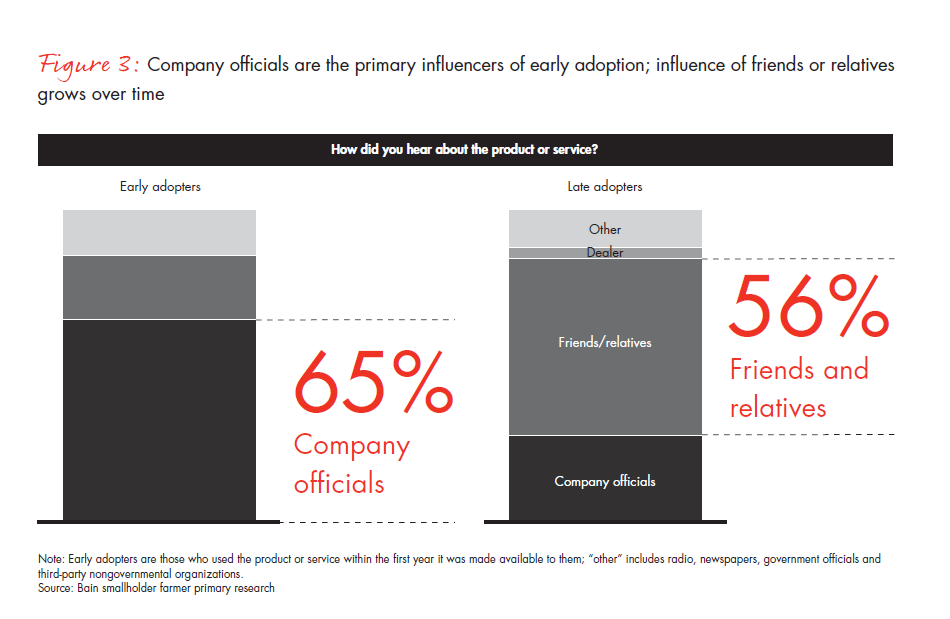
Farmers are more likely to consider an innovation when they trust the company and its personnel. As one farmer told us, “I do not take a company seriously until its people have come to my village at least three times.” Trust also helps to combat skepticism among farmers who may have experienced broken promises regarding the products they have received or purchased in the past from governments, NGOs or private enterprises. This trust-building prerequisite is the reason why selling to this segment is so time intensive and, hence, costly. Marketing new products and services requires high engagement with geographically dispersed farmer customers, thereby calling for both focus and patience from the company and its backers.
In the absence of traditional media, “promoters” are especially important for spreading and sustaining awareness. It is simply too hard and costly for firms to directly reach all their potential rural customers in the “high-engagement” manner described. This makes it all the more important to ensure that early adopters have a positive experience with the product or service. These promoters can then help spread the word about the product or service among those who have not yet adopted it. Conversely, if early adopters have a negative experience, they will warn others not to try a product or service. Over time, these influencers become the most important source of information about a product or service.
Based on our research, these crucial early adopters tended to be wealthier (see Figure 4). Though this observation is based on a limited data set, it makes sense that those with greater financial resources are in a better position to take greater risks or purchase products from savings; they also often have greater access to transportation, which helps to overcome obstacles to procuring the product or service. In addition, those with more wealth may be better educated and, therefore, better placed to understand the potential advantage that a product or service could provide. This data suggests that firms can be more deliberate in considering who their early adopters might be and can target their awareness-building efforts accordingly.
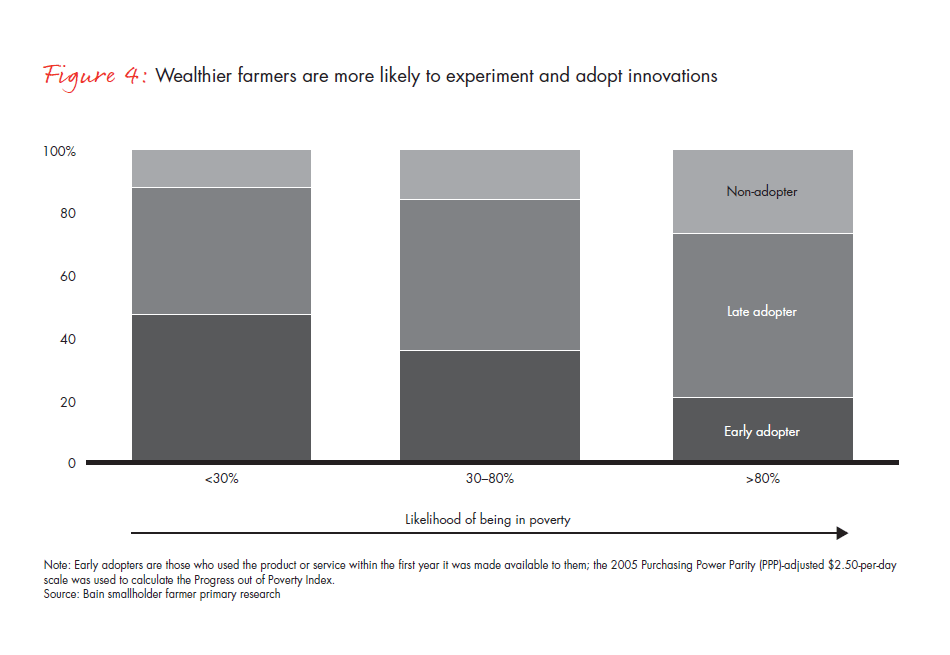
Other research has similarly emphasized the importance of social networks. For example, the recent Hystra report Marketing Innovative Devices for the Base of the Pyramid found, “A large percentage of [base of the pyramid] customers make a purchasing decision based on what their neighbors and relatives recommend to them: 92% for solar home systems, 60% for home improvement packages, 60% for improved cook stoves and 49% for irrigation pumps.”6
Advantage: “How much more benefit will I gain from this product or service relative to what I’m currently doing?”
Although advantage, in general, is paramount, the type of advantage also matters significantly. Our research indicates that the extent to which a product is seen to increase financial standing is the most powerful driver of adoption of an agricultural innovation. More than 60% of the farmer responses were related to how a product or service would increase wealth (see Figure 5).7 Farmers cited other considerations, such as mitigated risks or better service, less frequently as primary drivers of adoption. This means that firms targeting this segment must have a very clear and compelling explanation for how their product or service will directly increase customers’ income, ideally in the very short term.
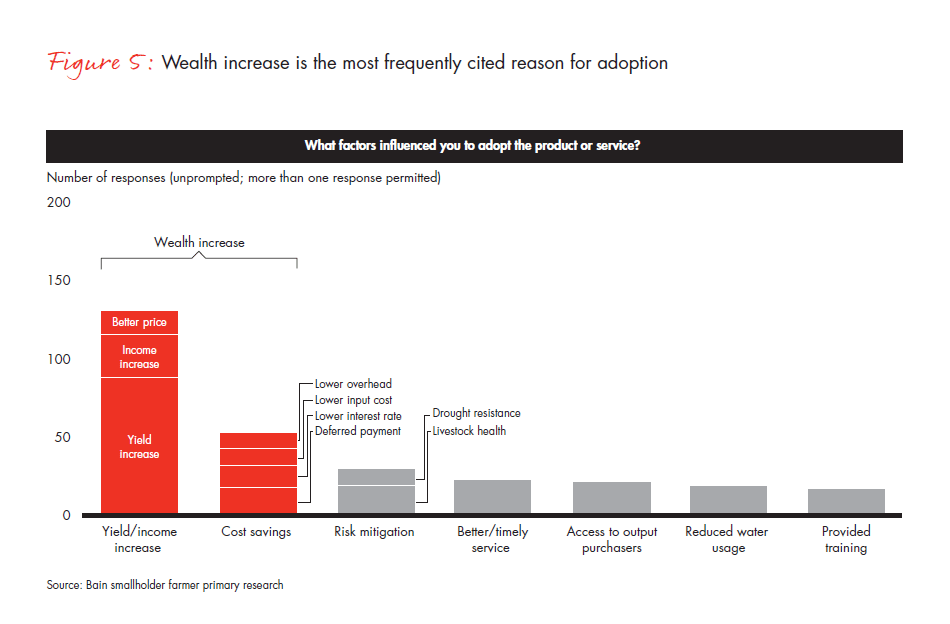
Not surprisingly, we found that the value placed on increased wealth was related to the level of poverty: Farmers in our sample who had an 80% or greater chance of being in poverty were more likely to mention wealth increase as influencing adoption of a product or service (see Figure 6).
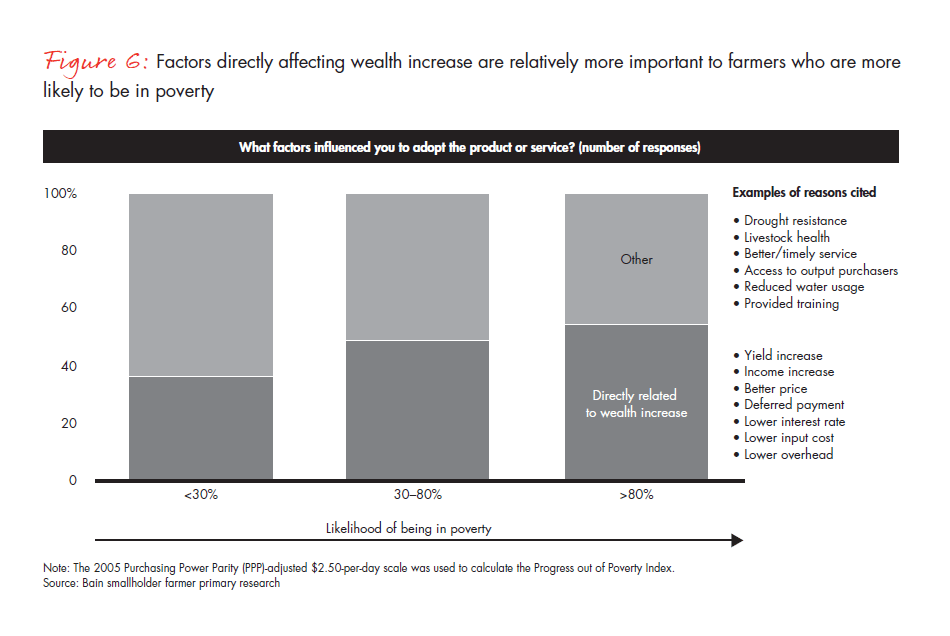
Experiencing the advantage through trying the product or service is crucial to sustained adoption. Eighty percent of the farmers we surveyed “trialed” a product or service, and of those, the vast majority bought enough for only one-half or less of their land (see Figure 7). This was true regardless of how much acreage they had, how wealthy they were and whether they were early or late adopters. With long feedback loops between usage and advantage, trialing can encourage farmers to adopt without having to risk their entire future harvest.
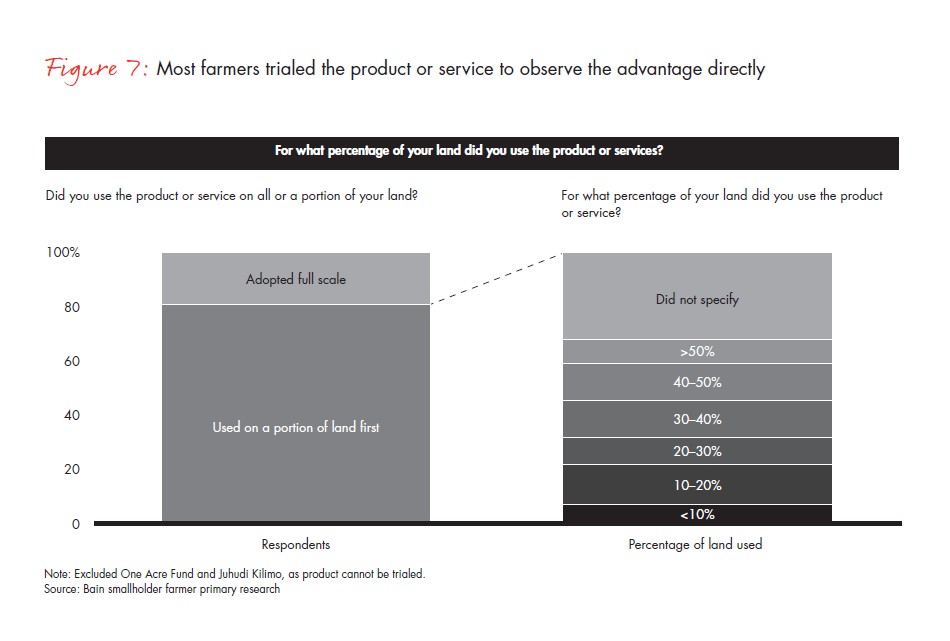
Affordability: “Do I have enough money at the right time to buy it?”
Smaller, incremental product or service sizes increase affordability. Farmers perceive affordability both in terms of the value a purchase can generate and the absolute cash outlays required. Allowing farmers to make small, incremental purchases directly addresses their cash outlay constraints while enabling them to test a product or service.
Access to financing can help farmers avoid the burden of making a large, lump-sum payment to purchase a product or service. Because their cash flows tend to be irregular, smallholder farmers value access to finance and flexibility in paying back loans. Almost one-third of the respondents to our survey who cited cost savings as the primary reason for their adoption of a product or service emphasized the importance of deferred payment. For example, many of the farmers we interviewed in Kenya readily pay 20% more for the OAF inputs package vs. what they would pay at a local store, because of the deferred payment scheme that the organization offers.
A product or service also has to be affordable at the right time. Because farmers’ cash flows align with harvesting cycles throughout the year, the timing of the purchase is almost as important as the absolute price. A new product or service feels much more affordable immediately after harvest, when farmers have either sold their surplus output and have cash on hand, or they have secured enough food for their families and, therefore, feel safer dipping into savings to purchase an innovation. Firms need to understand and map the cash-flow cycles of their target customers across the year based on what individual farmers are growing. An Acumen investee from an adjacent sector provides a good example: d.light, which produces and sells solar lights. They have had great success selling their products to farmers at local markets, literally within minutes of the farmers’ greatest spike in income after having sold their harvest.8
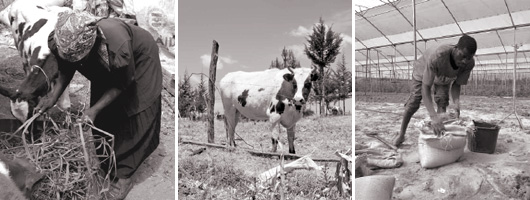
Access: “Can I get it easily when I need it?”
Whereas much has been made of the importance of last-mile distribution, our findings on this point were mixed. Without a doubt, devising a distribution and logistics capability to reach customers is crucial. However, among the farmers we spoke to, many reported that they had traveled considerable distances to reach formal retail outlets and purchase inputs. For example, Sidai, a formal retail outlet for veterinary services and agriculture inputs, has been able to sustain and grow its business by mostly selling to farmers who are willing and able to travel into small towns to purchase products and services.
Whether farmers perceive an agricultural innovation as accessible depends on their mobility constraints. For example, many of the farmers we spoke with in India are men who own motorcycles they can drive to the nearest store. They are willing and able to travel over longer distances to purchase a product or service. By contrast, many farmers we met with in Kenya are women who have no motorized transport. They must travel on foot, so agricultural innovations need to be located close by to be accessible for them.
A product or service must be available when it is needed. If seeds that must be planted before the rainy season arrive in a retail store one week after the rains or if semen for artificial insemination arrives after breeding animals are no longer in heat, the products are of no use to farmers even if they are brought to their doorstep. OAF considers access to be so critical that it insists on delivering its products to farmers on the day they need them to locations within walking distance.
Advantage carries the most weight of all the A’s
None of the Four A’s alone is sufficient to drive adoption of an innovation. However, if farmers do not consistently perceive that a product or service offers benefits beyond their current practices, they will not adopt it. Conversely, if the advantage conferred by an innovation is sufficiently large, adopters will be more willing to overcome the other key barriers of affordability—often saving cash or borrowing money to pay for the product—and access. For example, in the case of a number of farmers we spoke to in the drought-ravaged areas of Karnataka in India, many said they had taken loans at very high interest rates or driven more than 100 kilometers to secure the microdrip irrigation product that could mean the difference between having a crop or not.
Antecedents to the Four A’s The Four A’s framework is grounded in the study of the diffusion of agricultural innovations and informed by the well-known 4P’s marketing framework: product, price, place and promotion. One of the noted scholars of innovation diffusion, Everett Rogers, started his academic career examining the adoption of new agricultural technologies by farmers in the US in the middle of the 20th century. He determined that an innovation’s features strongly correlate with the expected speed of adoption. These features included the size of the improvement over a prior generation of a product (what we call “advantage”), the degree to which the innovation could easily become part of the farmers’ practices and the perceived complexity in using the product. The remaining features were how much the farmer would be able to experiment with the product (what we refer to as “trialing”) and the ease and speed with which the farmer could observe the benefits of the product. As we set out to interview our farmers, we had these traits in mind and, indeed, all of these elements feature throughout our Four A’s framework. The 4P’s were instrumental in helping us transform customer insights into actions for pioneer firms. The emphasis on the features and functionality (product), the price customers pay, how they hear about the product (promotion) and where they buy it (place) are evident in our model. However, the rural, agricultural context and the specific characteristics of smallholder farmers are sufficiently distinct to warrant our adaptation of this well-known framework. Critically, we emphasize the advantage provided by the product or service and the additional dimensions of affordability which must take into account the relative level of poverty and highly variable cash flows. Given that some products are not even known to many farmers, we found that awareness was more fitting and, of course, the dispersed and rural location of smallholder farmers led to the importance of access. The 4P’s also served as inspiration for a 2011 article C. K. Prahalad wrote called “Bottom of the Pyramid as a Source of Breakthrough Innovations.”9 In it, he coins his Four A’s: awareness, access, affordability and availability. |
||
Farmer profile: Cynthia
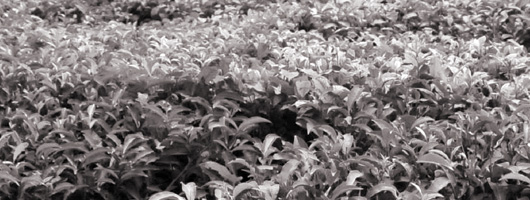
A late adopter of Juhudi Kilimo’s asset-backed microfinance
Cynthia* lives on a one acre farm near Eldoret, Kenya. She has six people in her family and grows maize and vegetables on her land.
Like many in Western Kenya, she wanted to own a cow for the milk it would produce for her family to consume. As she walked through her small village in December 2012, she noticed a neighbor’s cow looking particularly healthy. She asked her neighbor where she had purchased it and how she was caring for it. The neighbor said that she bought the cow with the help of Juhudi Kilimo. “She explained that this company gave her a loan for the cow and that she was now repaying it using the money she got from selling some of the cow’s milk to a local dairy,” says Cynthia. Juhudi Kilimo had lower interest rates, which would make it easier for her to pay back the loan over time. “I wanted to understand how it worked, so I spoke to another four people in my village who had taken loans with Juhudi Kilimo,” she says.
Given her family’s finances and the need to focus on her acre of planted maize and vegetables, Cynthia did not follow up with Juhudi Kilimo until June 2013. “Other people who had taken loans were meeting on a regular basis to talk about repayment,” she says, “and I saw them attending classes where they would learn about how to care for the cows better.” Eventually, Cynthia attended one of these trainings and asked for a loan to buy her own cow. “I wanted to own a cow for the extra food it provided my family and because I wanted to sell what milk we didn’t consume to make some additional income.”
Cynthia formed a group of five women who would support each other’s loans. Given the company was already operating in her community, she didn’t have to travel far to receive her loan. She bought her cow from another farmer only two kilometers from her home.
“The cow produces four liters of milk a day, and we consume two of them,” she says. “I sell the other two to another farmer with a motorcycle who takes the milk to a local dairy. I am planning to take another loan from Juhudi Kilimo to purchase another cow and buy a small plot of additional land.”
* Full name and select personal details have been disguised
NEXT · CHAPTER 3 ;· Promoting adoption: Challenges and opportunities
About our smallholder farmer survey
In developing this paper, we bring to bear the best of Bain & Company and Acumen. Bain has decades of experience helping private-sector companies achieve profitable growth, and we have tailored the concepts we use with large corporations to the context of agriculture-focused pioneer firms operating in developing countries.
To do this, we have benefited from Acumen’s extensive experience investing in and supporting pioneer firms serving low-income customers across the developing world and from its thoughtful synthesis of lessons learned to share with a broader audience. Together, we conducted a four-month study in South Asia (India and Pakistan) and sub-Saharan Africa (Ghana, Kenya and Uganda); our primary research with farmers was enhanced by interviews with management teams and frontline employees at 11 pioneer firms (both Acumen agriculture investees as well as other agricultural enterprises) providing a range of products or services to smallholder farmers. Finally, we drew on the advice and perspectives generously provided by a diverse group of more than 60 external experts from development organizations, corporations, universities, NGOs, investment funds and advisory firms to understand their perspectives on farmer adoption.
Our goal was to understand why a farmer had or had not adopted a particular product or service and how wider factors, such as local environment, educational background and level of poverty, informed the decision. The farmer communities where we conducted our interviews were selected to ensure there would be a sufficient mix of different types of adopters: “early” adopters, who tried the product or service within the first year of its introduction to their community; “late” adopters, who adopted the product or service after it had been available for more than one year; “non-adopters,” who never tried the product or service; and “discontinuers,” who tried the product or service but no longer used it.2 The characteristics of these farmers are as follows:
- 30% were early adopters, 45% were late adopters, 20% were non-adopters and 5% were discontinuers
- More than 75% owned five acres of land or less and owned fewer than five head of cattle
- One-half had less than a secondary-level education
- Interviewees were roughly equally distributed across four age groups: 21 to 30 years, 31 to 40 years, 41 to 50 years and 51 years and older
More than 70% of these farmers were men, owing, in part, to our stated desire to speak to the primary decision maker who determined whether the family should adopt a product or service and, in part, to the patriarchal structure of the societies in the areas included in our study.
Our survey questionnaire was designed to uncover how farmers came to learn about a particular innovation, from whom they heard about the product, where they first saw it, where they purchased it, how they bought it (cash or credit), what they thought it would do and whether the expected results were achieved. The Four A’s framework emerged from these conversations through analysis of their common answers, as well as from our literature review and discussions with experts in the field.
To determine the level of poverty in our sample, we used the Progress Out of Poverty Index (PPI): “[A] poverty measurement tool for organizations and businesses with a mission to serve the poor. The PPI is statistically sound yet simple to use: the answers to 10 questions about a household’s characteristics and asset ownership are scored to compute the likelihood that the household is living below the poverty line—or above by only a narrow margin. With the PPI, organizations can identify the clients, customers, or employees who are most likely to be poor or vulnerable to poverty, integrating objective poverty data into their assessments and strategic decision making.”3 Based on these questions, approximately three-fifths of our sample are living below the $2.50-per-person-per-day poverty line (based on 2005 purchasing-power parity-adjusted prices).4
This was consistent with other aspects of our findings, given that one prerequisite for a farmer’s investment in, and adoption of, an agricultural innovation is the belief that it will increase his or her income. This mindset is not to be underestimated in its importance to motivating adoption. Along these lines, the Syngenta Foundation has created a helpful segmentation of farmers into groups based on their level and sophistication of agricultural input adoption.5 Based on this categorization, most farmers we interviewed were either emerging from being subsistence farmers (unable to sell much of their output and needing to master the basics of soil and water management and use of manure) to being semi-commercial farmers (usually able to produce sufficient excess production to sell for income and using some level of hybrid seeds and synthetic fertilizer).
Our principal aim is not to provide new research on farmers themselves, given that there is already a wealth of research on this topic. Instead, we are focusing more specifically on ways of interpreting farmer behavior that are most useful for pioneer firms’ decision making.
1 Although advantage, affordability, awareness and access all strongly affect smallholder farmers’ willingness and ability to embrace and continue using agricultural innovations, other drivers of farmer behavior in general, such as sex, prior experience and sense of self (the way they view farming as either a profession or a necessity),will influence the adoption process. Such determinants may override other considerations for certain consumer segments. For example, marginalized farmers, such as women in a patriarchal society or landless persons who have little decision-making power, may feel that they are not capable of using or using correctly a particular technology, product or service. The Four A’s are still relevant for these segments, but are incomplete without the broader contextual understanding.
2 To ensure we had a sufficient mix of different types of farmers, we were assisted in identifying the villages in which we conducted our research by the pioneer firms. Though we note this as a possible source of bias, we feel the benefit of support from companies in identifying a good mix of interviewers outweighed this risk.
3 See Progress Out of Poverty, “About the PPI: A Poverty Measurement Tool,” Progress Out of Poverty’s website, www.progressoutofpoverty.org/about-ppi.
4 Data on poverty levels in India and Kenya, accounting for 80% of the sample, were significant to 95%. Data from Ghana were significant to 80%; data from Uganda were not significant.
5 Yuan Zhan, Smallholder Agriculture, Sustainability and the Syngenta Foundation, Basel: Syngenta Foundation, 2010.
6 Hystra, Marketing Innovative Devices for the Base of the Pyramid, Paris: Hystra, 2013.
7 Factors included yield increase, income increase, price increase for outputs, lower costs, deferred payments and reduced use of other inputs.
8 This example also highlights how multiples of the Four A’s incentives work in concert; in this case, affordability and access together drive a potential sale.
9 C. K. Prahalad, “Bottom of the Pyramid as a Source of Breakthrough Innovations,” Journal of Product Innovation Management 29, no. 1 (2011): 6–12.




